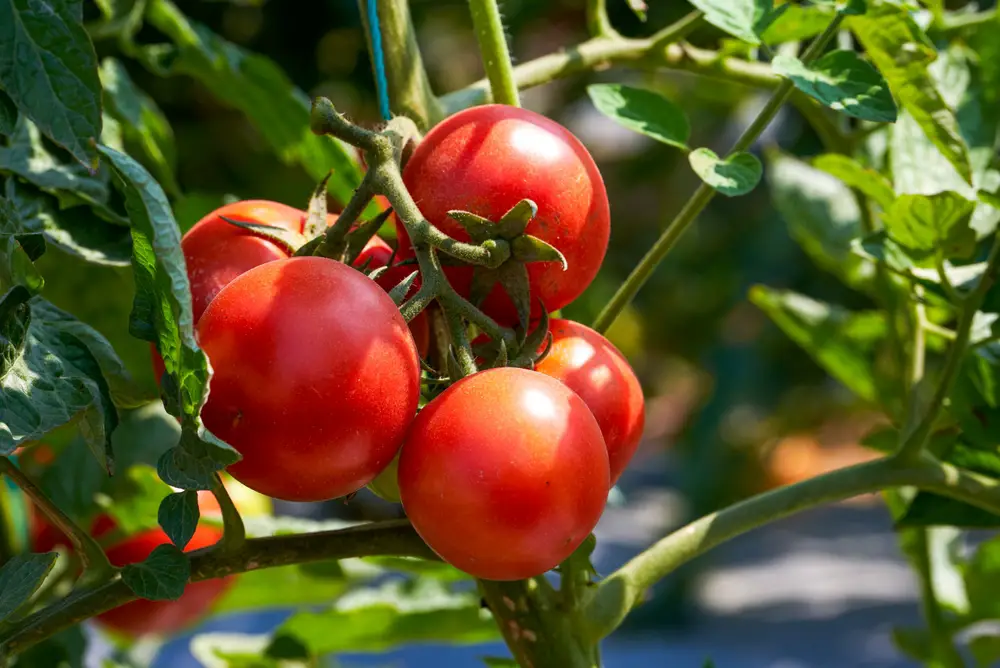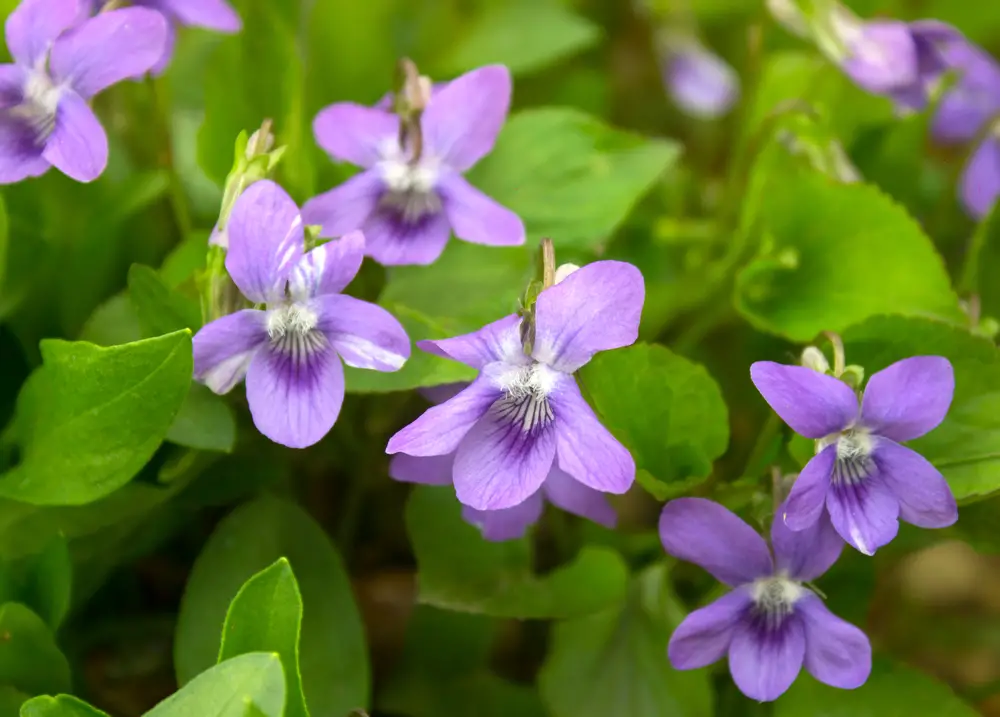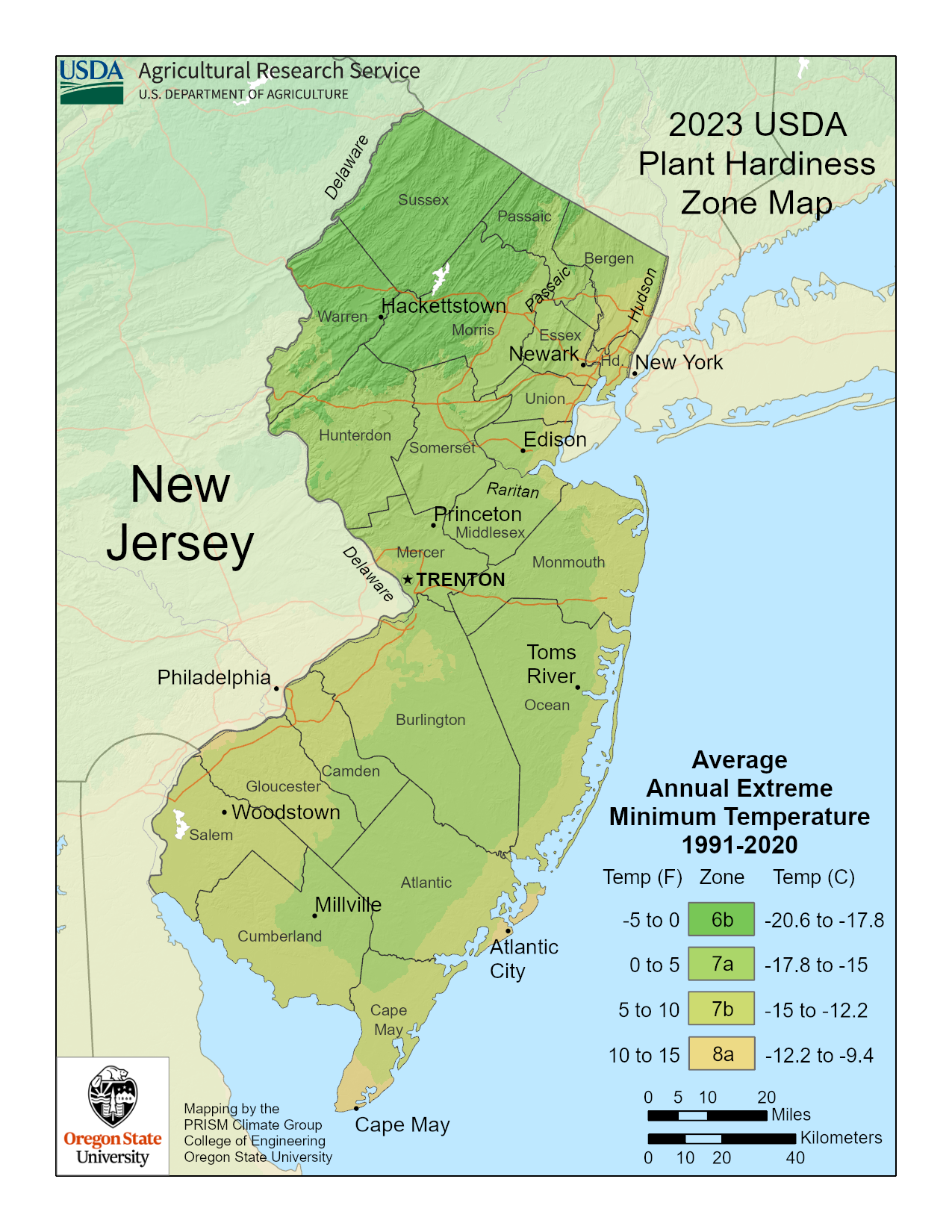New Jersey Plant Hardiness Zones
| USDA Hardiness Zone | Average Minimum Extreme Winter Temperature Range Fahrenheit (°F) Celsius (°C) | Average Last Frost Date Range In Spring (Beginning Of The Growing Season) | Average First Frost Date Range In Autumn (End Of The Growing Season) |
|---|---|---|---|
| 6b | -5°F to 0°F -20.6°C to 17.8°C | Late April to early May | Mid to late October |
| 7a | 0°F to 5°F -17.8°C to -15°C | Late April to early May | Early to mid-October |
| 7b | 5°F to 10°F -15°C to -12.2°C | Early April to mid-April | Late October to early November |
| 8a | 10°F to 15°F -12.2°C to -9.4°C | Late March to early April | Early to mid-November |
New Jersey Growing Conditions

Credit to Wikipedia
General Climate
New Jersey’s hardiness zones range from 6b to 8a. While most of the state has a humid subtropical climate, the north experiences a more continental climate with hot to warm summers.
Temperatures vary from west to east due to the proximity to the Atlantic Ocean. The northwest experiences cooler temperatures with four distinct seasons, each with fluctuating temperatures.
As you move east, the overall temperature increases and the seasons and weather patterns become less distinct. This is due to the Atlantic Ocean’s moderating effects.
The ocean moderates the weather of New Jersey because large bodies of water take longer to heat up and cool down than land does. They absorb and emit the heat slowly, thus keeping summers cooler and winters more mild.
Microclimates
USDA plant hardiness zones are an important starting point for your garden, but you’ll also need to consider microclimates.
Microclimates are areas where specific conditions create a climate different from the climate they’re situated in.
Buildings, fences, paved areas, or short hills and valleys can create these microclimates.
They can be as small as a space in your backyard or as large as a city.
In other words, learn about your local conditions from local experts to see if your garden falls into a microclimate.
Extreme Weather
Nor’easters
Nor’easters occur in New Jersey from November to April. The northern portion of the state experiences more snow during these weather events while the south has more rain.
Nor’easters are common during winter months along the eastern shore of America. Nor’easters are a type of storm caused by harsh winds blown in from the northeast (hence the name).
Rain is a good thing! But too much rain causes soil saturation, root rot and flooding. Heavy rain also causes branches to snap and damages trees and shrubs. It’s best to remove dead and damaged branches, to ensure less breakage. It also encourages strong branch growth and development.
Thin and delicate plants are vulnerable to heavy rains and wind. Try staking your plants with supports like metal or wooden posts. This gives the plants the extra support they need in high winds and heavy rain.
Drought
Even with lots of rain, New Jersey can experience bouts of drought. When this happens, it’s good to be prepared to help your plants survive. One of the keys to growing success is good quality soil.
When soil is nutrient rich it retains more moisture to keep your plants hydrated in hot weather. Soils that are clay based or have too much sand dry out really quickly!
Add compost to your soil every fall to help build quality soil. If you struggle with sand or clay based soils, try coconut coir. It is a sustainable amendment to help break up clay and retain moisture.
Growing Season
New Jersey sees an average of 180 growing days each year. The length of the growing season depends on where you are located within the state.
Proximity to the ocean has a great effect on the weather patterns. Coastal New Jersey sees a longer growing season while the northwest has the shortest amount of frost-free days.
New Jersey Gardening Tips

Grow the State Vegetable: The Tomato!
The tomato is New Jersey’s state vegetable. Even though tomatoes are commonly known as vegetables, they are actually fruits.
Tomatoes are fun to grow and delicious to eat. There are a couple of different ways to prune tomatoes to help produce higher yields.
One way is to prune the leaves and leave the suckers. This pruning method means that the plant puts all its energy into each fruiting sucker, rather than leaf development. By doing this, the plant produces more fruit in the growing season.
If your goal is to have bigger fruit, then it is best to prune the suckers rather than the leaves. This method controls how many fruits are cultivated. By removing shoots that produce lots of fruits, the plant directs its energy into growing bigger tomatoes.
Prune your tomatoes once a week. Only prune the bottom third of the plant so that the tomato still has leaves on top to create shade.
Support the Endangered Monarch Butterfly
Monarch butterflies are native to New Jersey. Unfortunately, these powerful pollinators are an endangered species.
Monarch butterflies are essential to create thriving, biodiverse ecosystems. They do so by pollinating many species of wildflowers.
Monarchs have an extensive and unique migration. They travel thousands of miles across North America. By growing flowers that support Monarchs, you are providing them with the vital food source they need to complete their long journey.
By conserving the habitat for Monarchs, you are also helping to preserve habitat for other beneficial pollinators. This is an important step in building a secure and sustainable future. Pollinators help us pollinate our food! Without them, the agriculture industry would be in trouble.
To support the Monarch, plant flowers that support all life stages:
Caterpillar
As with all butterflies, the Monarch starts its life cycle as a caterpillar. Milkweed is highly beneficial to the growth and development during the caterpillar lifestage. So, make sure to find a place for milkweed in your garden.
Adult
For the adult life stage, planting a diverse range of plants is important. These plants provide nectar for the butterfly. Nectar provides energy for breeding, aids in migration and gives them the energy needed for overwintering.
Nectar-rich plants Monarch butterflies love are:
- Aster
- Echinacea
- Wild Bergamot
Avoid using pesticides in your garden. Pesticides can kill Monarchs and are detrimental to other beneficial insects.
Consult With Local Professionals
Consulting with local gardening professionals allows you to benefit from their experience with your area’s conditions, the plants that do well there, and overall best practices.
New Jersey Plant Suggestions

Trees
- Yellow Buckeye (Aesculus flava)
- Yellow Birch (Betula alleghaniensis)
- American Hornbeam (Carpinus caroliniana)
Shrubs
- Smooth Alder (Alnus serrulata)
- Running Serviceberry (Amelanchier stolonifera)
- Sea Myrtle (Baccharis halimifolia)
Flowers
- Four Leaf Milkweed (Asclepias quadrifolia)
- Heath Aster (Aster ericoides)
- Blue Star (Amsonia tabernaemontana)
Vegetables
- Curly Leaf Kale (Brassica oleracea Acephala)
- Tomatoes (Solanum lycopersicum)
- Peas (Pisum sativum)
Herbs
- Yellow Giant Hyssop (Agastache nepetoides)
- American Angelica (Angelica atropurpurea)
- White Sage (Artemisia ludoviciana)
Spices
- SpiceBush (Lindera benzoin)
- Chives (Allium schoenoprasum)
- New Jersey Tea (Ceanothus americanus)
Fruits
- Paw Paw (Asimina triloba)
- Beaked Hazelnut (Corylus cornuta)
- American Persimmon (Diospyros virginiana)
Succulents
- Corsican Stonecrop (Sedum dasyphyllum)
- Eastern Prickly Pear (Opuntia humifusa)
- Purple Haze (Sempervivum heuffelii)
Disclaimer
Any of the above can change and is not exhaustive.
Treat anything above like a good starter guide. Then use that as a foundation as you consult with local gardeners, professionals, forecasts, guides, and organizations.

